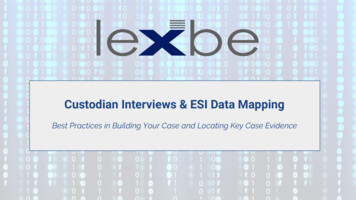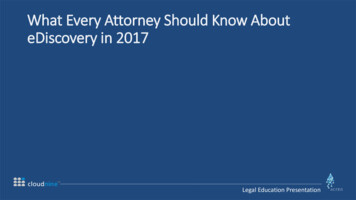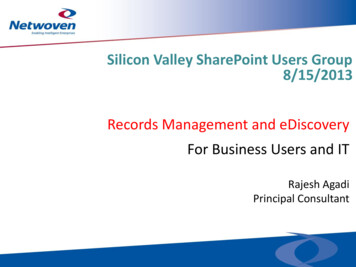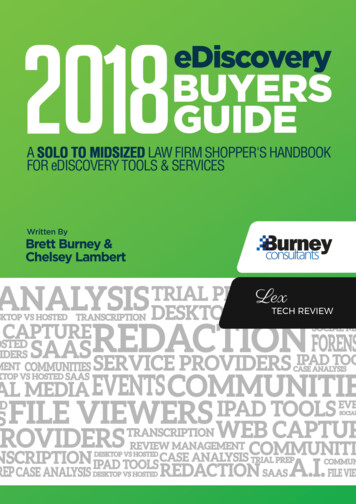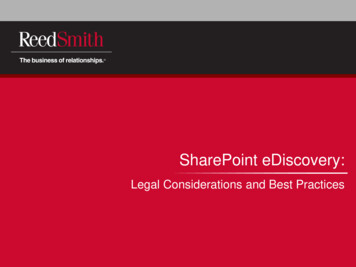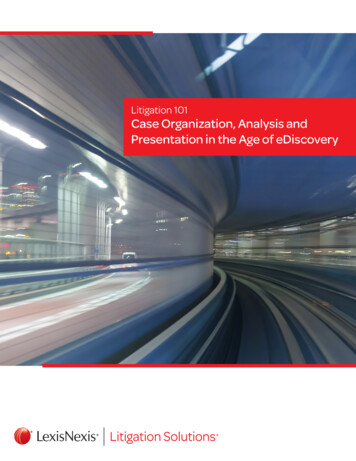
Transcription
WHITE PAPERBest Practices for eDiscovery andRegulatory Compliance in Office 365 NAn Osterman Research White PaperPublished September 2016Sponsored bySPONsponsored bysponsored bysponsored byOsterman Research, Inc.P.O. Box 1058 Black Diamond, Washington 98010-1058 USATel: 1 206 683 5683 Fax: 1 253 458 0934 info@ostermanresearch.comwww.ostermanresearch.com @mosterman
Best Practices for eDiscoveryand Regulatory Compliance inOffice 365EXECUTIVE SUMMARYeDiscovery and compliance are essential activities for any organization, regardless ofits size, the industry that it serves or the jurisdictions in which it operates. To be sure,“heavily” regulated organizations – such as those in the financial services, healthcare,life sciences, energy and certain other markets – face higher levels of complianceobligation than their less heavily regulated counterparts. However, every organizationmust factor eDiscovery and compliance into its communications and collaborationstrategy.KEY TAKEAWAYS Microsoft Office 365 provides a successful and popular set of communicationsand collaboration capabilities, and its use will continue to grow at a rapid pace.Although Microsoft has been offering hosted/cloud-based offerings for more than15 years, Office 365 is the most successful iteration of the company’s cloudbased communications and collaboration offerings to date. eDiscovery and compliance obligations are becoming more onerous and morecomplex over time. However, these are essential capabilities that decisionmakers must consider in the context of their communications, collaboration, filesharing, storage and other strategies. These complications are being driven by a number of factors, including the rapidproliferation of electronic information, the increasing number of data types thatmust be retained for legal and regulatory purposes, the increasing amount ofdata that employees manage independently of IT, and increased governmentoversight into corporate activities. Increasing regulation, oversight and court actions create an ever more complexminefield of Discovery and regulatory requirements, a situation that will becomeonly more difficult over time. A failure to adequately address these issues willincrease corporate risk. Microsoft has done a good job at building eDiscovery and compliance capabilitiesinto Office 365 and should be commended for doing so. However, there are anumber of limitations and deficiencies in Office 365 from an eDiscovery andcompliance context that decision makers should consider as they evaluateMicrosoft’s offerings. Even more so in environments that operate both Microsoftand non-Microsoft solutions.eDiscovery andcomplianceobligations arebecoming moreonerous andmore complexover time.ABOUT THIS WHITE PAPERA survey was conducted for this white paper and some of the results from it areincluded herein. However, all of the results will be published in a separate surveyreport shortly after the publication of this white paper.This white paper and survey was sponsored by Archive360. Information on thecompany, as well as their relevant solutions, is provided at the end of this paper.INCREASING USE OF OFFICE 365Microsoft Office 365 – the company’s third major iteration of its hosted/cloud-basedemail and collaboration offerings – is the most successful of its solutions to date. Thecompany has been (and we anticipate will continue to be) successful in converting itsbase of on-premises users of Exchange and other solutions to Office 365. As shownin Figure 1, the survey conducted for this report demonstrates that growth of Office365 will be rapid over the next 24 months as on-premises users of Exchange andother platforms migrate to the cloud. 2016 Osterman Research, Inc.1
Best Practices for eDiscoveryand Regulatory Compliance inOffice 365Figure 1Deployment of Various On-Premises and Cloud-Based Solutions2016 and 2018Being able tofind, secure andproduceinformationwhen requestedby a court orregulator is anessentialresponsibilitypresent in oneform or anotherin everyindustrializedcountry.Source: Osterman Research, Inc.THE CRITICAL IMPORTANCE OF eDISCOVERYWHAT ARE DISCOVERY AND eDISCOVERY?The process of discovery can be viewed in a couple of ways: As a relatively strict set of requirements focused on searching for content thatmay be relevant for use as evidence in a trial or in pre-litigation activities.Viewed in this way, discovery can include any sort of document or otherinformation that might be useful to prove a plaintiff’s or defendant’s case in acivil action. Viewed in a broader context, however, discovery is the ability to search forcontent not only within the confines of court-ordered discovery activities, butalso all of the efforts focused on finding information that could somehow berelevant for any litigation- or compliance-related activity, such as seniormanagers performing informal early case assessments or mid-level managerssearching for potentially damaging content in their employees’ email or socialmedia posts.“eDiscovery”, then, is just the extension of well-established discovery processes toany Electronically Stored Information (ESI) that an organization possesses – emailmessages, social media posts, voicemails, presentations, word processing files,spreadsheets, CRM data and all other relevant communication or information thatcould be useful in a legal action. eDiscovery can extend to any platform on which ESIis stored: desktop computers, laptops, servers, smartphones, tablets, backup tapes,and even employees’ home computers and other personally owned devices.Being able to find, secure and produce information when requested by a court orregulator is an essential responsibility present in one form or another in everyindustrialized country. It is also a responsibility that, if taken lightly, can cost anorganization dearly in the form of fines, sanctions, penalties, lost business, or higherlegal costs. At its heart, an effective and compliant eDiscovery or compliance process 2016 Osterman Research, Inc.2
Best Practices for eDiscoveryand Regulatory Compliance inOffice 365is highly dependent on a well-managed information governance capability. Costs andrisks of eDiscovery and compliance skyrocket when an organization does not havecontrol of their enterprise data and therefore cannot find all requested information fora legal action within the timeframe allowed by the court. Costs are also negativelyimpacted by finding too much data (over-collection) or not finding all relevantinformation (under-collection).ELECTRONIC DATA IS INCREASING RAPIDLYIt should be a surprise to no one that ESI is accumulating rapidly. For example, anOsterman Research survey conducted during March 2016 found that organizationsstore a mean of 49.3 gigabytes of just email data per user (a particularly interestingdata volume given that Office 365 offers 50 gigabytes of email per useri), and thattotal messaging-related storage during the previous 12 months had increased a meanof 18 percent. Based on even this relatively modest rate of growth, 49.3 gigabytes in2016 will increase to 133 gigabytes over just six years, as shown in Figure 2.Figure 2Storage Growth Based on an Increase of 18 Percent per Year2016-2022The vast majorityof dataaccumulatingwithin the typicalenterprise is ofthe unstructuredvariety, usuallycontrolled and“managed” byindividualemployees.Source: Osterman Research, Inc.The vast majority of data accumulating within the typical enterprise is of theunstructured variety, usually controlled and “managed” by individual employees.Much of this unstructured data is considered “dark data” because it is invisible andnot easily accessible by the company. Instead of being stored on managed electroniccontent management (ECM) systems, this data is normally stored on employeeworkstations, removable media, enterprise file shares, or even outside theorganization’s control on employee-managed personal clouds. Dark data poses agrowing cost and liability to the organization because it is still considered anorganizational asset and within its scope of responsibility, and is a major concern inthe context of compliance, eDiscovery and data leaks.While email is often one of the primary sources of discoverable information, otherdata types are becoming increasingly important to consider in the context ofeDiscovery and compliance. This includes electronic files, social media posts, wikis,blogs, SMS/text messages, SharePoint and other data repositories, databases, CRMdata and a growing number of other data types. 2016 Osterman Research, Inc.3
Best Practices for eDiscoveryand Regulatory Compliance inOffice 365KEY OBLIGATIONS TO CONSIDEREvery organization faces some level of eDiscovery and compliance obligations. A setof general and common requirements are imposed across many industries, countries,and regions: ESI should be captured, stored securely, and be unchangeable once it has beencaptured. Email is the primary form of electronic communication in business andorganizational life today, but obligations generally extend to other forms ofrelevant electronic communication, such as instant messaging chats, files,content in collaboration systems (e.g., SharePoint) and social media posts.Organizations using paper forms of communication need to capture and preservethese kinds of records as well. Archived communications must be retained for various lengths of time, normallyon the order of three to seven years, but sometimes much longer. The recordsmust not be deleted during this period, nor modified, nor should anyone havethe ability to tamper with them. When necessary, organizations must be able to produce authentic copies of allcontent that meets certain criteria. This requires robust search tools that canidentify relevant communications, keep them organized, and make it easy forthese collections to be furnished for further review. Once the retention period for communications has been reached, this contentcan be validly deleted in most cases. However, if messages that have reachedtheir expiration date are being held for a current or potential investigation(litigation, or legal hold), deletion must not occur until the hold has been lifted. Itis essential to note that items placed on legal hold will need to be retainedbeyond their retention period until the legal action is concluded and the legalhold has been removed. At that time they can be safely deleted if they are olderthan the length of the retention period. Unauthorized access to systems and data should not occur. A method ofcontrolling access to systems and data is necessary, and encryption of data mayalso be necessary. Robust access controls are essential, as are specific definitionof the organizational roles that will have access to the archive. When records can be deleted, it should occur swiftly with a carefully prescribedplan for “defensible deletion” – the practice of identifying and deleting data thatis no longer needed and retention of which would increase corporate risk.ESI should becaptured, storedsecurely, and beunchangeableonce it has beencaptured.THE FEDERAL RULES OF CIVIL PROCEDUREThe Federal Rules of Civil Procedure (FRCP) are a set of rules, first established in1938, that provide the basic ground rules for civil litigation in the United States. Therules were updated significantly in 2006, most notably to codify the concept of ESI.The result of the 2015 changes to the FRCP will be shorter and more limiteddiscovery periods, the requirement to be better prepared for eDiscovery quickly oncethe litigation process starts, and attorneys must be ready to address claims andproportionality issues in the context of eDiscovery. Key changes to the rules includethe following: The discovery process is now more limited than it was previously in order tominimize the pain it imposes on all parties to litigation. Whereas the 2006 changes to the FRCP focused on the provision of ESI, the2015 changes modify the focus to preservation of ESI. The new rule imposes“curative” measures when ESI is lost or absent, which may make an inability toproduced requested information during discovery more expensive andconsequential. 2016 Osterman Research, Inc.4
Best Practices for eDiscoveryand Regulatory Compliance inOffice 365 Parties under the previous FRCP rules could simply object to a request for theproduction of information. The new rules require the objecting party to state thespecific reasons for its objection and the party “must state whether anyresponsive materials are being withheld on the basis of that objection”.eDISCOVERY REQUIREMENTS AND COMMON MISTAKESDecision makers can learn from court decisions about what to do – and what not todo – in the context of eDiscovery. Here are some notable lessons that decisionmakers should take to heart: Backups can create problems for the eDiscovery processBackups, either on tape or on disk, are a poor method for retaining discoverablecontent because accessing this content is time-consuming, expensive and maynot produce all of the necessary information. eDiscovery must not be overly broadAlthough an older case, Moulin Global Eyecare Holdings Ltd. v. KPMG is useful toconsider because the court rejected the plaintiffs’ arguments for a discoveryrequest that it considered too expansive. The court determined that allowing thistype of broad access to the defendant’s electronic content would be “tantamountto requiring the defendants to turn over the contents of their filing cabinets forthe plaintiffs to rummage through.ii” Not retaining ESI can lead to sanctionsIn Frank Gatto v. United Air Lines, the plaintiff deleted his Facebook content,access to which had been requested by the plaintiffs. The court agreed with thedefendant’s motion and issued an adverse instruction, one of the worst possiblesituations for any party to a legal actioniii. By archiving ESI in a compliantmanner, companies can defend themselves against these types of doomsdayscenarios in a set-and-forget fashion. Informationsubject to[regulatory]retentionrequirementsshould be treatedwith care, muchlike informationsubject toeDiscovery.Demonstrating that appropriate material was usedMany recruiters use social media content in their process of evaluatingcandidates. However, employers cannot consider a candidate’s race, religion,sexuality or certain other types of information. If an employer uses social mediaas part of the hiring process, it should archive the content it used aboutcandidates to demonstrate that it did not evaluate material that could not belegally considered. A failure to do so – and an employer’s inability todemonstrate its good faith evaluation of this information during eDiscovery –could result in serious consequences. Relevant regulations in this regard includethe Americans with Disabilities Act, the Age Discrimination in Employment Act,the Civil Rights Act of 1964 and Executive Order. No. 11,246iv.COMPLIANCE AND INDUSTRY REGULATIONSTHE CONCEPT OF REGULATIONS AND COMPLIANCEREQUIREMENTSMost nations impose some form of regulatory obligations for records retention thatdirect what information must be retained and for how long. Information subject tothese retention requirements should be treated with care, much like informationsubject to eDiscovery, because of the potential penalties and fines for not followingthe laws. Data subject to compliance requirements that is not managed and retainedin compliance with these regulations can trigger government information requests.These can quickly transform into expensive legal proceedings, fines, and maybe evenjail time.THE KEY REGULATIONSIn the United States, the key regulations that impose requirements on organizationsinclude the following: 2016 Osterman Research, Inc.5
Best Practices for eDiscoveryand Regulatory Compliance inOffice 365 HealthcareThe Health Insurance Portability and Accountability Act of 1996 (HIPAA)establishes various requirements on Protected Health Information – informationabout an employee’s health that can be linked to his/her identity. There arevarious technology, policy, and procedural requirements to safeguard suchinformation when stored and transmitted. Financial ServicesThe Securities and Exchange Commission (SEC), Financial Industry RegulatoryAuthority (FINRA), Dodd-Frank Act, PATRIOT Act, and Gramm-Leach Bliley Act(GLBA) – as well as other requirements – impose various obligations on financialservices organizations. FINRA, for example, establishes requirements on thecapture, monitoring, and archiving of broker/trader communications, anddemands a supervisory review process. The Dodd-Frank Act has created theFinancial Stability Oversight Council and implements a variety of supervision andoversight controls on financial institutions. The PATRIOT Act specifies an identitytrail for customers opening new accounts. GLBA imposes rules on the privacy offinancial information about customers and sets standards on how to protect thisinformation. Publicly Traded OrganizationsSarbanes-Oxley (SOX) requires that the financial records of publicly tradedcompanies be retained for up to seven years and available for review by the SECat any time. Organizations that Serve the US Federal GovernmentThe Federal Acquisitions Regulations (FAR) require that contractors to the USfederal government retain all records, both hard copy and electronic, forbetween two and four years. This covers organizations providing both goods andservices. Federal, State and Local GovernmentsThe Freedom of Information Act (FOIA) gives citizens the right to request accessto records held by any federal entity other than Congress or the Judicial branch(most states and many local governments have similar provisions known as“open-records” or “sunshine” laws.) The current administration has directedfederal agencies to work in a spirit of cooperation with requesters under FOIA.While agencies can respond to FOIA requests in the order in which they arereceived, there are situations where expedited processing is required. Designated High-Risk OrganizationsChemical manufacturing and energy distribution facilities, along withtransportation operations, are designated as high-risk operations under theHomeland Security Act. Such organizations have security and recordkeepingrequirements to which they must adhere.There are manycomplianceobligations thatare an importantor criticalconsideration fororganizationsthat havedeployed or maydeploy Office365.Outside of the United States, different nations, regions, and economic blocs havetheir own set of regulations, such as the EU Data Protection Directive for data privacyin the European Union, as well as similar regulations for financial servicesorganizations in the United Kingdom. There are many compliance obligations that arean important or critical consideration for organizations that have deployed or maydeploy Office 365, as shown in Figure 3. 2016 Osterman Research, Inc.6
Best Practices for eDiscoveryand Regulatory Compliance inOffice 365Figure 3Top Ten Regulations That Impact OrganizationsPercentage Indicating “Important” or “Critical” ConsiderationsRegulationHealth Insurance Portability and Accountability Act (HIPAA)Sarbanes-Oxley Act of 2002Federal Information Security Management Act of 2002 (FISMA)Gramm-Leach-Bliley Act (GLBA)Federal Rules of Civil ProcedureFamily Educational Rights and Privacy Act (FERPA)Dodd-FrankUS-EU Safe Harbor FrameworkSSAE 16SEC Rule 17a-4%38%28%22%21%17%15%14%14%13%12%Source: Osterman Research, Inc.REGULATIONS AND COMPLIANCE ARE COMPLEXRegulatory and legal compliance is a complex undertaking. There are manyregulations and compliance requirements for all organizations, and an awareness ofthese is essential to avoid the penalties that can result from non-compliance.Unfortunately, there is no single overarching regulation for all organizations, nor anysingle compliance action that will deliver everything that is necessary. The complexityis such that: Regulations differ by nation, industry, legal jurisdiction and business function.For organizations that operate across multiple nations or across multipleindustries, defining an internal compliance approach is fraught with complexity.It is a challenging task to reconcile the differing requirements and decide on thebest way forward. Regulations can also be in conflict and inconsistent, so that what must beretained for one regulation does not need to be retained for another.Alternatively, while the duration of retention for one regulation might be sevenyears, another may require only three years of retention. Compliance with regulatory obligations is also a dynamic field, where newregulations are introduced to right certain wrongs, or regulations are revised toconsolidate past attempts and bring them up-to-date.There are manyregulations andcompliancerequirements forall organizations,and anawareness ofthese is essentialto avoid thepenalties that canresult from noncompliance.Decision makers should engage compliance professionals to ensure they areoperating in alignment with current requirements and best practices.COMPLIANCE IN AN IDEAL WORLDBecause of the complexity of regulatory compliance, most organizations aspire todemonstrate the following three characteristics: Retain only what is necessary to retain, for as long as necessary, andno longer.This means capturing information at the right trigger point, classifying this datafor retention, and storing each form of data in a tamper-proof repository, in asearch-ready state, for as long as necessary. When records can be deleted, itshould occur swiftly with a carefully prescribed plan for “defensible deletion”.Employees must know what they should and should not do to remain incompliance, and should follow the policies, procedures, and system requirementscorrectly. 2016 Osterman Research, Inc.7
Best Practices for eDiscoveryand Regulatory Compliance inOffice 365 Quickly identify suspect or non-compliant contentThe organization should be able to demonstrate appropriate actions taken toaddress this type of content. This should be in a proactive sense to minimizedownstream harm, or in response to a request for information from an externalbody. Manage content with as little risk as possibleDecision makers should employ systems, policies, and training to minimize thecompliance risks in an organization, such as inaccurate identification of contentfor retention, systematic failures to delete appropriate content, and insufficientcare by employees in following corporate policies. Increasingly, analyticscapabilities are being applied on top of archived content to identify informationwhich could pose security, compliance or legal risks to the organization. Thesecapabilities can proactively surface communications content which may put theorganization at risk, and enable the company to address it before it becomes alarge problem.COMPLIANCE AND eDISCOVERY IN OFFICE 365MICROSOFT’S APPROACH TO COMPLIANCE IN OFFICE 365While Microsoft has taken great pains to provide compliance capabilities in Office 365– and has done a good job at doing so – we believe there are some weaknesses withMicrosoft’s approach to eDiscovery in Office 365 when organizations operate a hybridenvironment of Office 365 and on-premises solutions. Let’s look at the evidence tosupport our contention.While Microsofthas taken greatpains to providecompliancecapabilities inOffice 365 – andhas done a goodjob at doing so –we believe thereare someweaknesses withMicrosoft’sapproach INCOMPLETE CAPTURE OF CONTENTOrganizations cannot find what they have not captured, and eDiscovery requires afoundation of content completeness. Office 365 does not support the full capture ofcontent, nor its retention if captured. For example: Deleted email purged after 14 daysUnless the user’s Exchange Online mailbox is on legal hold, email they deletefrom their mailbox is moved to a hidden folder and then purged 14 days later. InExchange Online, the 14-day timeframe can be increased to a maximum of 30days. Partial capture of Skype for Business contentBy default, conversations in Skype for Business (and Lync before that) are storedin the user’s Conversation History folder in Outlook. However, this setting can beturned off by the user with a simple click. Even with it turned on, however, onlytext-based instant messaging interactions and file upload actions into meetingsare captured; peer-to-peer file transfers, audio and visual interaction for instantmessages and conferences, application sharing, and conferencing annotationsare not captured. The capturing of instant messaging conversations can beforced, but only by putting the user’s mailbox on legal hold. Deletion of Skype for Business meeting contentAttachments to a Skype for Business meeting are deleted after eight hours (forad hoc meetings) and 15 days (for one-time and recurring meetings, with the 15days counter starting at different times for each type of meeting). No capture of Yammer contentContent in Yammer is not captured for archiving, even though it is a core part ofthe Office 365 offering. With new Yammer capabilities supporting sharing andcollaboration scenarios with external parties, the archive is blind to whathappened, and thus eDiscovery is too. Customers do have the option of includingYammer content, but only in conjunction with a third-party ingestion service. 2016 Osterman Research, Inc.8
Best Practices for eDiscoveryand Regulatory Compliance inOffice 365 Audit reports deleted after 90 daysReports of actions taken by IT administrators and people who have access to themailbox of another user are retained for 90 days and then deleted. Office 365cannot report on actions taken more than 90 days prior to an eDiscovery contentsearch since the data is not stored.THE ARCHITECTURE REQUIRES THAT ALL MAILBOXES ARECONSTANTLY ON LEGAL HOLDEntire user mailboxes must be placed on legal hold in order for certain types of datato be captured and archived in Office 365. For example: Skype for Business and LyncInstant messaging conversations from Skype for Business (or the previousgeneration of Lync) will be archived into the user’s mailbox only if their mailboxis placed on legal hold. Instant messaging conversations are captured by defaultby the Skype for Business client and stored in a folder in Outlook, but this can beturned off by the user. Putting the mailbox on legal hold forces the capture. Third-party data sourcesMicrosoft’s recent foray into supporting the ingestion of non-Office 365 datasources for archiving and eDiscovery in Office 365 requires that the user’smailbox be set to In-Place Hold in order for archiving to work. .organizationswill bear theadditional risk ofstoring whatcould be verylarge amounts ofdata for longperiods withoutthe ability todefensibly deletethis content andthereby reducetheir corporaterisk.In addition, some information is available only in an eDiscovery search if legal hold isturned on. Specifically, BCC information for emails are stored in the sender’s mailbox,which must be on hold in order for that information to be returned. The logicalimplication, therefore, is that in order to uncover BCC information, all mailboxes needto be on legal hold during an eDiscovery search, and relatedly, if a sender’s mailboxis deleted before a three to seven year retention period for email data, thatinformation will not be available.If the legal hold mechanism – which is conceptually intended to be used to preventthe deletion of data in face of a pending or current lawsuit – is permanently requiredin order for basic capture and search processes to work, organizations will retain fartoo much data and may be unable to defensibly delete over time. That said, someindustries are obligated to retain some types of information for long periods and sooperate under a sort of permanent, de facto legal hold.This means that organizations will bear the additional risk of storing what could bevery large amounts of data for long periods without the ability to defensibly deletethis content and thereby reduce their corporate risk. Many third-party solutions donot suffer from this limitation and should be considered not only from the perspectiveof reducing storage requirements, but, more importantly, from the perspective ofreducing the risk of retaining too much content.A PROLIFERATION OF eDISCOVERY APPROACHES ACROSSMICROSOFT’S OWN PRODUCTSMicrosoft does not offer a unified approach to eDiscovery across its tools, but insteadthere is an ever-changing roster of capabilities that differ by product and productversion. For example: Exchange Server 2016Organizations quick to embrace Exchange Server 2016 can search both onpremises Exchange 2016 mailboxes and public folders, as well as Office 365based mailboxes and public folders in the same search. In-Place eDiscovery inExchange 2016 cannot search non-Exchange content. When searching publicfolders, the only option is to search all public folders, and all public folders mustbe put on hold (there is no granularity to support only putting specific publicfolders on hold). 2016 Osterman Research, Inc.9
Best Practices for eDiscoveryand Regulatory Compliance inOffice 365 SharePoint Server 2013The eDiscovery Center in SharePoint Server 2013 works only with SharePoint2013 and Exchange 2013; earlier versions of Exchange Server are not supported.The eDiscovery Center can search for content in SharePoint on-premises, but forarchitectural reasons is unable to search SharePoint Online. A separateeDiscovery Center is required for SharePoint Server 2013 on-premises andSharePoint Online. Office 365 Security & Compliance CenterThe recently released Security & Compliance Center can search content inSharePoint Online, Exchange Online (mailboxes and public folders), OneDrive forBusiness, and Office 365 Groups. It does not search other Office 365 contentnatively – such as Yammer – and does not search any on-premises content.For compliance and legal professionals, the problems with this approach include:
Best Practices for eDiscovery and Regulatory Compliance in Office 365 is highly dependent on a well-managed information governance capability. Costs and risks of eDiscovery and compliance skyrocket when an organization does not have control of their enterprise dat


